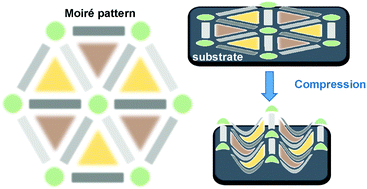Our official English website, www.x-mol.net, welcomes your feedback! (Note: you will need to create a separate account there.)
Moiré-templated strain patterning in transition-metal dichalcogenides and application in twisted bilayer MoS2†
Nanoscale ( IF 6.7 ) Pub Date : 2018-10-29 00:00:00 , DOI: 10.1039/c8nr06269b Shuze Zhu 1, 2, 3, 4 , Harley T. Johnson 1, 2, 3, 4
Nanoscale ( IF 6.7 ) Pub Date : 2018-10-29 00:00:00 , DOI: 10.1039/c8nr06269b Shuze Zhu 1, 2, 3, 4 , Harley T. Johnson 1, 2, 3, 4
Affiliation

|
To take full advantage of the electronic properties of transition-metal dichalcogenides and their vdW layered structures, it will be necessary to control the local electronic structure, on which the effect of lattice deformation is significant. Nevertheless, a general approach to programming nanoscale morphology in TMD materials, which would permit local strain engineering, has proven elusive. In this work, we propose a general moiré-templated nanoscale morphology engineering method based on bilayer TMDs. The moiré superlattice plays the key role in enforcing in-plane periodical variations in local interlayer spacing and potential energy. Upon global in-plane compression, the high-energy, large-interlayer-separation stacking domains serve as periodic buckling initiation sites. The buckled features can be thus precisely correlated to the moiré periodicity. The spatial profile of the buckled morphology and strain field are possible to be pre-determined, providing a bridge to the electronics and optoelectronics design. We take twisted bilayer MoS2 to demonstrate our approach. We further demonstrate how the morphology can modulate band gap and optical absorption of a MoS2 monolayer, envisioned as a potential constituent layer in a Moiré-templated, strain-engineered vdW heterostructure of TMDs. The robustness and programmable nature of our approach arise from superlattice symmetry, energetics and mechanics. Our approach provides a new strategy for on-demand design of morphology and local strain in TMDs under mechanical deformation.
中文翻译:

过渡金属二卤化物中的莫尔模板应变图案及其在双层MoS 2 †中的应用
为了充分利用过渡金属二氢硫化物及其vdW层状结构的电子特性,有必要控制局部电子结构,在该结构上晶格变形的影响很大。然而,事实证明,对TMD材料中的纳米级形态进行编程的通用方法是可行的,该方法可以进行局部应变工程。在这项工作中,我们提出了一种基于双层TMD的通用的莫尔模板纳米级形态工程方法。云纹超晶格在强制局部层间间距和势能的平面内周期性变化中起着关键作用。在全局平面内压缩时,高能量,大层间分隔的堆叠域用作周期性屈曲的起始位点。弯曲的特征因此可以精确地与莫尔周期性相关。弯曲形态和应变场的空间轮廓可以预先确定,为电子学和光电子学设计提供桥梁。我们采用扭曲的双层MoS2演示我们的方法。我们进一步展示了形态学如何调节MoS 2单层的带隙和光吸收,该MoS 2单层被设想为TMDs的莫尔模板化,应变工程化的vdW异质结构中的潜在组成层。我们的方法的鲁棒性和可编程性来自于超晶格对称性,能量学和力学。我们的方法为机械变形下TMD的形貌和局部应变的按需设计提供了新的策略。
更新日期:2018-10-29
中文翻译:

过渡金属二卤化物中的莫尔模板应变图案及其在双层MoS 2 †中的应用
为了充分利用过渡金属二氢硫化物及其vdW层状结构的电子特性,有必要控制局部电子结构,在该结构上晶格变形的影响很大。然而,事实证明,对TMD材料中的纳米级形态进行编程的通用方法是可行的,该方法可以进行局部应变工程。在这项工作中,我们提出了一种基于双层TMD的通用的莫尔模板纳米级形态工程方法。云纹超晶格在强制局部层间间距和势能的平面内周期性变化中起着关键作用。在全局平面内压缩时,高能量,大层间分隔的堆叠域用作周期性屈曲的起始位点。弯曲的特征因此可以精确地与莫尔周期性相关。弯曲形态和应变场的空间轮廓可以预先确定,为电子学和光电子学设计提供桥梁。我们采用扭曲的双层MoS2演示我们的方法。我们进一步展示了形态学如何调节MoS 2单层的带隙和光吸收,该MoS 2单层被设想为TMDs的莫尔模板化,应变工程化的vdW异质结构中的潜在组成层。我们的方法的鲁棒性和可编程性来自于超晶格对称性,能量学和力学。我们的方法为机械变形下TMD的形貌和局部应变的按需设计提供了新的策略。



























 京公网安备 11010802027423号
京公网安备 11010802027423号